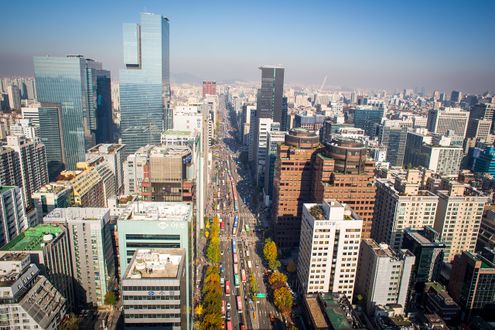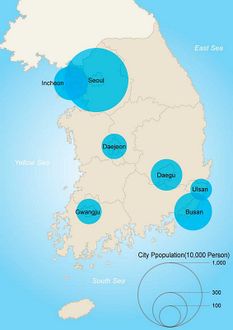"Population Change and Urbanization"의 두 판 사이의 차이
(새 문서: {{Kor Article| |Article= }} <gallery mode=packed heights=220px> </gallery> <gallery mode=packed heights=220px> </gallery> =='''Related Articles'''== *[[]] =='''References'''== <re...) |
|||
| (같은 사용자의 중간 판 3개는 보이지 않습니다) | |||
| 1번째 줄: | 1번째 줄: | ||
{{Kor Article| | {{Kor Article| | ||
| − | |Article= | + | |Article=인구변동과 도시집중화 |
}} | }} | ||
| + | The rapid urbanization and industrialization of Korea since the 1960s caused the inflow of cheap rural labor into industrial sites. More than 50% of Korea’s population now live in the Seoul and Incheon metropolitan areas and the Gyeonggi Province surrounding them. The wave of urban concentration that started in the 1960s is now stagnant, but many problems arise as more than 90% of the population reside in urban areas. | ||
| + | |||
| + | First, there was a big housing problem. The growing population has exceeded the housing supply, pushing up the house prices and making it difficult to own a home. While the housing penetration rate of the nation as a whole is 102.3, population is severely concentrated in urban areas. In seven major cities across the country, the number of people who have their own homes is just over 50%. Total home ownership ratio of Korea is 55.6% but Seoul scored the lowest with just 44.6%. | ||
| + | |||
| + | The government is constantly developing many new housing units, especially large-scale apartment complexes, and entire new suburban cities every year to solve housing problems in urban areas. But the problem of future housing is not easy either. A sudden increase in the number of single-person households has caused new housing problems. Demand for small apartments has far outstripped supply. The number of single-person households has already surpassed 5 million nationwide and the housing supply policy is shifting to a small one-person house. | ||
| + | |||
| + | Migration of the Korean population has also brought significant change in the form of families. Large families that occupied 20% of the total families in the 1970s collapsed when young people left for the city. In 2015, only 4.2% of total families are large families. | ||
| + | |||
| + | The number of elderly couples living alone continued to grow—from 5.4 percent in 1970 to 21.9 percent in 2015, a phenomenon that occurs when mature children leave home to live near their workplace. | ||
| + | |||
| + | Transportation is another problem. Newly constructed highways and roads connect Seoul’s surrounding area like a spider-web to meet the growing need for roads as more people start driving their own vehicles. However, the extension of roads cannot keep up with the explosive increase of automobiles and the government and municipalities are working together to resolve this issue. | ||
| + | |||
| + | Recently, more Koreans are moving out of the cities, but the recent trend has yet to become a meaningful phenomenon. | ||
<gallery mode=packed heights=220px> | <gallery mode=packed heights=220px> | ||
| + | File:3-27.강남거리_Gangnam Station Street.jpg|Gangnam / Courtesy of the Korea Tourism Organization (Kim Hang-ni) | ||
| + | File:3-28.명동_Myeong-dong Street.jpg|Myeongdong / Courtesy of the Korea Tourism Organization (IR Studio) | ||
| + | File:3-28.아파트촌_Complete View of Seoul.jpg|Apartments in Seoul / Courtesy of the Korea Tourism Organization (Bak Seong-geun) | ||
</gallery> | </gallery> | ||
<gallery mode=packed heights=220px> | <gallery mode=packed heights=220px> | ||
| + | File:030(E).jpg|South Korean City Population | ||
</gallery> | </gallery> | ||
=='''Related Articles'''== | =='''Related Articles'''== | ||
| − | |||
=='''References'''== | =='''References'''== | ||
2017년 11월 29일 (수) 10:02 기준 최신판
The rapid urbanization and industrialization of Korea since the 1960s caused the inflow of cheap rural labor into industrial sites. More than 50% of Korea’s population now live in the Seoul and Incheon metropolitan areas and the Gyeonggi Province surrounding them. The wave of urban concentration that started in the 1960s is now stagnant, but many problems arise as more than 90% of the population reside in urban areas.
First, there was a big housing problem. The growing population has exceeded the housing supply, pushing up the house prices and making it difficult to own a home. While the housing penetration rate of the nation as a whole is 102.3, population is severely concentrated in urban areas. In seven major cities across the country, the number of people who have their own homes is just over 50%. Total home ownership ratio of Korea is 55.6% but Seoul scored the lowest with just 44.6%.
The government is constantly developing many new housing units, especially large-scale apartment complexes, and entire new suburban cities every year to solve housing problems in urban areas. But the problem of future housing is not easy either. A sudden increase in the number of single-person households has caused new housing problems. Demand for small apartments has far outstripped supply. The number of single-person households has already surpassed 5 million nationwide and the housing supply policy is shifting to a small one-person house.
Migration of the Korean population has also brought significant change in the form of families. Large families that occupied 20% of the total families in the 1970s collapsed when young people left for the city. In 2015, only 4.2% of total families are large families.
The number of elderly couples living alone continued to grow—from 5.4 percent in 1970 to 21.9 percent in 2015, a phenomenon that occurs when mature children leave home to live near their workplace.
Transportation is another problem. Newly constructed highways and roads connect Seoul’s surrounding area like a spider-web to meet the growing need for roads as more people start driving their own vehicles. However, the extension of roads cannot keep up with the explosive increase of automobiles and the government and municipalities are working together to resolve this issue.
Recently, more Koreans are moving out of the cities, but the recent trend has yet to become a meaningful phenomenon.



